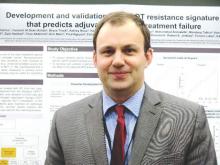SAN FRANCISCO – A new gene signature may take some of the guesswork out of selecting men with localized prostate cancer for adjuvant androgen deprivation therapy (ADT), according to a study reported at the 2016 Genitourinary Cancers Symposium.
The signature captures expression of 12 genes involved in neuroendocrine differentiation, which is known to be a marker of resistance to hormone therapy, according to first author Dr. R. Jeffrey Karnes of the Mayo Clinic, Rochester, Minn.
Results of the study of 785 men treated with radical prostatectomy for high-risk disease indicated that among the group given adjuvant ADT, those with a high signature were 71% more likely to experience failure of this therapy, as evidenced by the development of metastases, than did their peers with a low signature.
“If you were considering treatment with androgen deprivation therapy in an adjuvant fashion for disease that meets certain criteria, such as lymph node invasion, and some people will treat patients with seminal vesicle invasion, and you profile their tumor and they have a high score, a high androgen-resistance signature, you might want to consider something else,” Dr. Karnes said in an interview. “This is hypothesis generating, but the next steps are maybe looking at the signature in a randomized trial.”
In addition, it will be helpful to evaluate the predictive value of the signature when assessed in biopsy tissue and, at the other extreme, when assessed in metastases that are already present at the time of diagnosis, he said.
In the latter setting, “if a patient has a high signature, maybe that’s somebody you definitely – irrespective of the volume of [his] disease – want to treat [him] with chemohormonal therapy if [he] had a high signature, because this is sort of a marker of an innate or inherent resistance to castration.”
For the study, Dr. Karnes and his colleagues used the Decipher Genomics Resource Information Database (GRID) to analyze gene expression profiles of primary tumors from men treated with radical prostatectomy, with or without radiation therapy, for high-risk prostate adenocarcinoma.
They developed the gene signature in 360 men and validated it in 425 men. Overall, about a third of the cohort received ADT.
During follow-up, 35% of the men developed metastases (49% of those given ADT and 29% of those not given ADT), according to data reported in a poster session at the symposium, sponsored by the American Society of Clinical Oncology, ASTRO, and the Society of Urologic Oncology.
In Kaplan-Meier analysis among men treated with ADT, those with a high ADT resistance signature were more likely to develop metastases (P = .03). In contrast, among men not treated with ADT, the signature did not predict this outcome.
In a multivariate analysis, a high ADT resistance signature was associated with an elevated risk of metastases for men given ADT even after taking into account a variety of clinicopathologic features, surgical margin status, and receipt of various treatments (hazard ratio, 1.71; P = .02).

